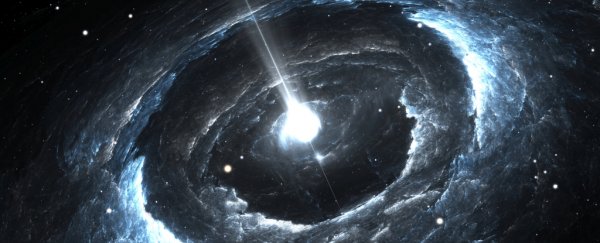Astronomers have identified what could be the most massive neutron star to date.
It's a pulsar, named J0740+6620, and discrepancies in the timing of its pulses has allowed its mass to be calculated to 2.14 times that of the Sun, packed into a star just 30 kilometres (19 miles) across.
To put that into perspective, the Sun has a diameter of 1.391 million km (~864,000 miles).
These measurements make J0740+6620 the first neutron star over 2 solar masses measured within the 68 percent confidence interval, and bring it cuttingly close to the rotating neutron star upper limit of 2.3 solar masses calculated last year based on gravitational wave astronomy.
And that could bring us closer to understanding the upper limits of these extreme objects.
Neutron stars form from stars that start out between around 8 and 30 times the mass of the Sun. As they die, these stars eject their outer material out into space via a series of thermonuclear explosions, fusing every last scrap of available material in their remaining cores.
Once the core has completely burned to iron, the pressure maintaining it falls away, and the core collapses, packing the neutrons until they are occupying the smallest space possible. The resulting object has the density equivalent to an atomic nucleus.
This is similar to the process that produces a black hole, which occurs with more massive objects; however, no black hole has been detected below 5 solar masses.
What occurs between that neutron star upper limit and black hole lower limit is still a mystery - but one that massive neutron stars could shed some light on.
How astronomers calculated the mass of J0740+6620 is really clever - and relies a lot on the properties and orientation of the star from Earth.
J0740+6620, located around 4,500 light-years away, is a millisecond pulsar. That means that it's rotating insanely fast, and it's angled in such a way that beams of bright radio waves shooting from its magnetic poles sweep past Earth on every rotation - on millisecond scales. (Here's what that sounds like transcribed into audio.)
The regularity of these pulses can be used for a variety of applications, but when they show faint irregularities, that can be really revealing too.
The pulsar is in a binary system with a white dwarf, and that brings us to the second piece of the puzzle: the system is edge-on to Earth, so that the white dwarf passes between us and the pulsar - what is called a transit.
The way that white dwarf's gravity just every-so-slightly disrupts the regularity of the pulses is how a team of astronomers led by Thankful Cromartie of the University of Virginia the National Radio Astronomy Observatory measured the pulsar's mass.
This disruption is called the Shapiro time delay (animated above), and it occurs when the path of the light from the pulsar is bent by the gravity of the white dwarf, causing it to take slightly longer to travel to Earth when the white dwarf passes between us and the pulsar. And we do mean slightly - the difference is just 10 millionths of a second.
Cromartie and her team combined five years' worth of survey data with two dedicated observing campaigns, and were able to determine the precise timing of the delay. This allowed them to figure out how much the white-dwarf's gravity was bending space time, which in turn allowed them to infer the white dwarf's mass.
Once the mass of one object in a binary system is known, calculating the mass of the other object is a straightforward process - returning a mass of 2.14+0.10−0.09 M⊙ within the 68.3 percent credibility interval.
We don't actually know how massive a neutron star can get. The commonly cited figure is 3 solar masses, but the truth is that none have been detected over 2.5 solar masses.
The most massive neutron star could be PSR J2215+5135, a pulsar with an estimated mass of 2.27 solar masses, measured with magnesium lines; or PSR B1957+20, with an estimated mass as high as 2.4 solar masses, based on radial velocity inferred from spectra. Both these methods, the team noted, are less reliable than the precision offered by radio timing.
There's also the slightly less massive PSR J0348+0432, clocking in at 2.01 solar masses, also calculated using the Shapiro time delay.
Whether or not this latest pulsar is the most massive neutron star yet, the research is sure to teach us more about these enigmatic stars.
"Neutron stars are as mysterious as they are fascinating," Cromartie said.
"These city-sized objects are essentially ginormous atomic nuclei. They are so massive that their interiors take on weird properties. Finding the maximum mass that physics and nature will allow can teach us a great deal about this otherwise inaccessible realm in astrophysics."
The research has been published in Nature Astronomy.

